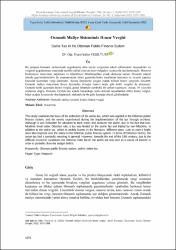| dc.contributor.author | Yeşilyurt, Şahin | |
| dc.date.accessioned | 2023-09-05T13:10:47Z | |
| dc.date.available | 2023-09-05T13:10:47Z | |
| dc.date.issued | 26.09.2022 | en_US |
| dc.identifier.citation | Yeşilyurt, Ş. (2022). Osmanlı Maliye Sisteminde Hınzır Vergisi . Afyon Kocatepe Üniversitesi Sosyal Bilimler Dergisi , 24 (3) , 1075-1089 . DOI: 10.32709/akusosbil.1060756 | en_US |
| dc.identifier.uri | https://dergipark.org.tr/tr/pub/akusosbil/issue/72686/1060756 | |
| dc.identifier.uri | https://hdl.handle.net/11630/10682 | |
| dc.description.abstract | Bu çalışma Osmanlı maliyesinde uygulanmış olan hınzır vergisinin tahsil edilmesinin dayanakları ve verginin uygulanması esnasında tecrübe edilen olayları arşiv belgeleri vasıtasıyla incelemektedir. Hınzırın beslenmesi, ticaretinin yapılması ve tüketilmesi Müslümanlara yasak olmasına karşın, Osmanlı idaresi altında gayrimüslimlerin de yaşamasından ötürü gayrimüslimler tarafından beslenen ve ticareti yapılan hınzırlar üzerinden vergi alınmıştır. Ayrıca literatürde yaygın olarak bilinen hınzır vergisine ilaveten, Osmanlı maliye sisteminde hınzır üzerinden örneğin resm-i bojik gibi farklı vergiler de alınmıştır. Osmanlı tarihi açısından hınzır vergisi, genel itibariyle sembolik bir anlam taşımıştır. Ancak 19. yüzyılın sonlarına doğru, Osmanlı Devleti‟nin içinde bulunduğu zorlu iktisadi koşullardan ötürü hınzır vergisi, bütçe açığını kısmen de olsa kapatmak maksadıyla bir gelir kaynağı olarak görülmüştür. | en_US |
| dc.description.abstract | This study examines the basis of the collection of the swine tax, which was applied in the Ottoman public finance system, and the events experienced during the implementation of the tax through archives. Although it was forbidden for Muslims to feed, trade, and consume the swine, due to the fact that nonMuslims lived under Ottoman rule, a tax was levied on the swine fed and traded by non-Muslims. In addition to the swine tax, which is widely known in the literature, different taxes, such as resm-i bojik, were also imposed over the swine in the Ottoman public finance system. In terms of Ottoman history, the swine tax had a symbolic meaning in general. However, towards the end of the 19th century, due to the difficult economic conditions the Ottoman State faced, the swine tax was seen as a source of income in order to partially close the budget deficit. | en_US |
| dc.language.iso | tur | en_US |
| dc.publisher | Afyon Kocatepe Üniversitesi | en_US |
| dc.identifier.doi | 10.32709/akusosbil.1060756 | en_US |
| dc.rights | info:eu-repo/semantics/openAccess | en_US |
| dc.subject | Osmanlı Maliye Sistemi | en_US |
| dc.subject | Hınzır | en_US |
| dc.subject | Hınzır Vergisi | en_US |
| dc.subject | Ottoman Public Finance System | en_US |
| dc.subject | Swine | en_US |
| dc.subject | Swine Tax | en_US |
| dc.title | Osmanlı maliye sisteminde hınzır vergisi | en_US |
| dc.title.alternative | Swine tax in the Ottoman Public finance system | en_US |
| dc.type | article | en_US |
| dc.relation.journal | Afyon Kocatepe Üniversitesi Sosyal Bilimler Dergisi | en_US |
| dc.department | Seçiniz | en_US |
| dc.authorid | 0000-0002-2193-8052 | en_US |
| dc.identifier.volume | 24 | en_US |
| dc.identifier.startpage | 1075 | en_US |
| dc.identifier.endpage | 1089 | en_US |
| dc.identifier.issue | 3 | en_US |
| dc.relation.publicationcategory | Makale - Ulusal - Editör Denetimli Dergi - Başka Kurum Yazarı | en_US |



















